Abstract
Anorexia nervosa is notoriously difficult to treat, but little is known regarding the relationship of compliance to treatment outcome. We investigated in 41 adolescents who fulfilled DSM-III-R criteria for anorexia nervosa, the relationship between the completion of a standard psychosocial treatment program, subtypes of anorexia nervosa, and outcome as determined by standardized measurements. These adolescents were observed for an average of 32.4 months. Overall, 29 patients (70%) improved considerably, but 10 (24%) were symptomatic, and 2 (5%) remained in poor condition. There were no deaths. Of the 41 patients, 14 (34%) completed our entire treatment program, 15 (37%) received major treatment and failed in the outpatient follow-up phase only, 7 (17%) dropped out of inpatient treatment before its completion, and 5 (12%) refused treatment in our system altogether. Of all the dropouts, 10 received no further treatment. One patient was admitted to hospital elsewhere but again dropped out in the outpatient phase of that program. Seven patients (17%) received further outpatient treatment only, and 9 (22%) received inpatient and outpatient care and seemingly completed their treatment. Treatment completion significantly affected the measures of global clinical functioning and specific psychopathologic features, but only for those patients who completed the initial program. Bulimic patients did considerably worse on follow-up and were less likely to complete treatment. Patients with restricted anorexia nervosa were more likely to complete treatment than those with a bulimic subtype (P = .03). Differential compliance rates in the two subtypes confound the effects of treatment completion and need to be controlled for in future studies. Depression was not associated with noncompliance but, if present, was associated with poor outcome on follow-up and abated in only a third of those in whom it was initially present.
Full text
PDF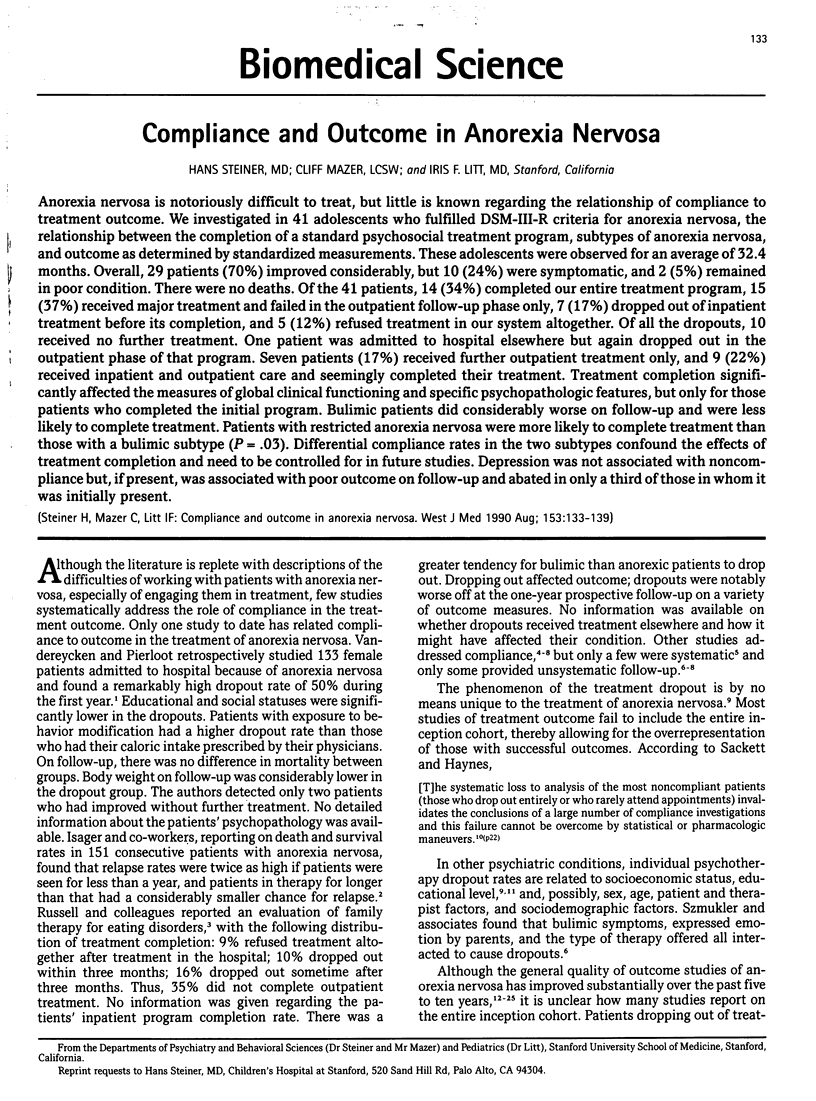
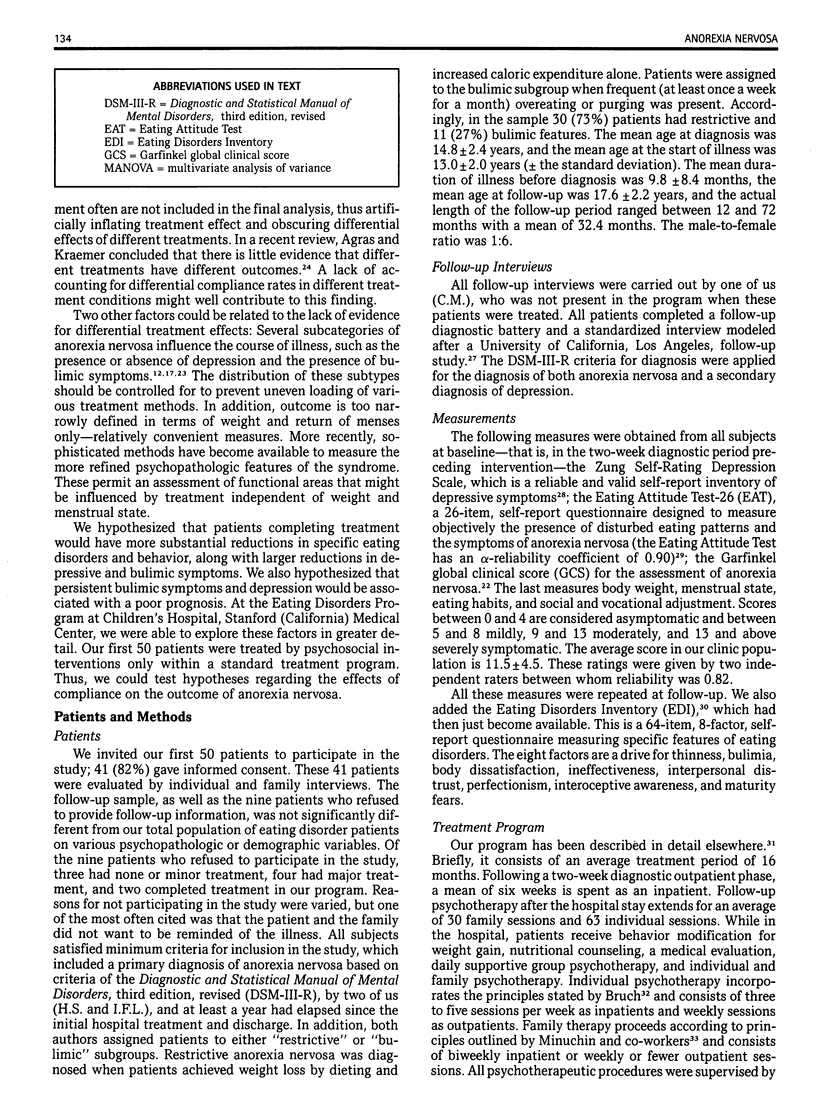

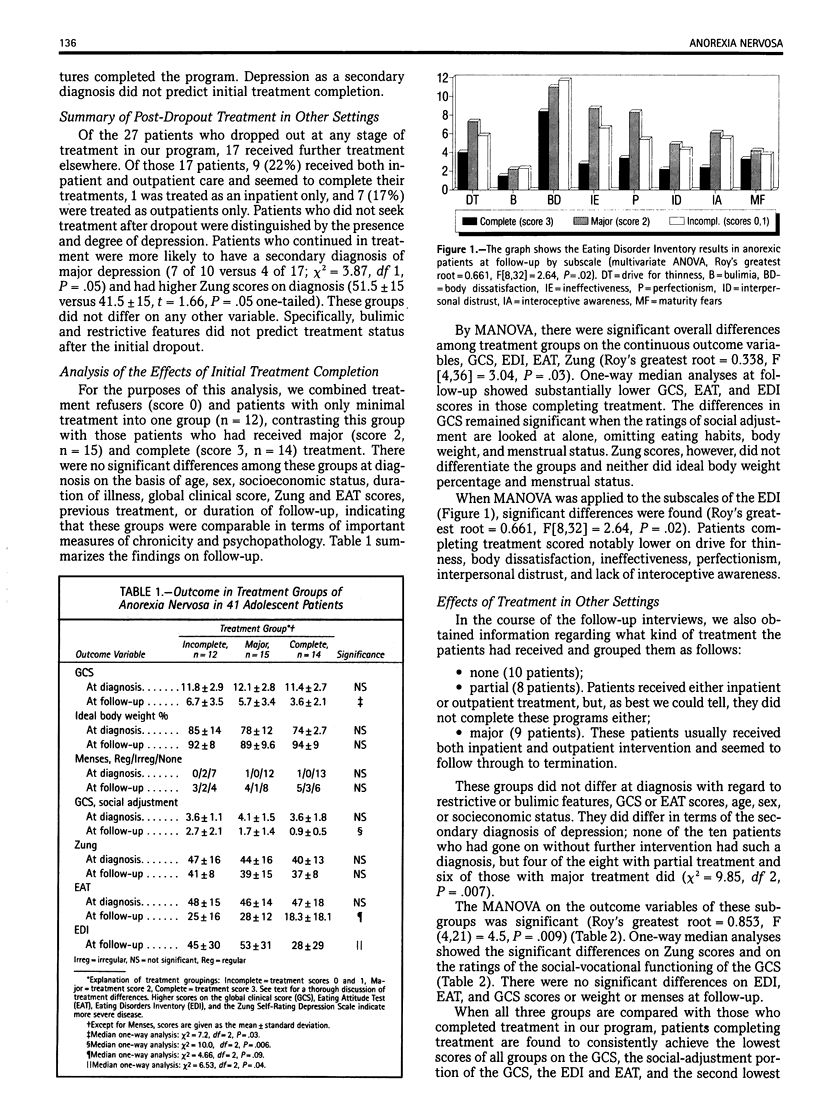
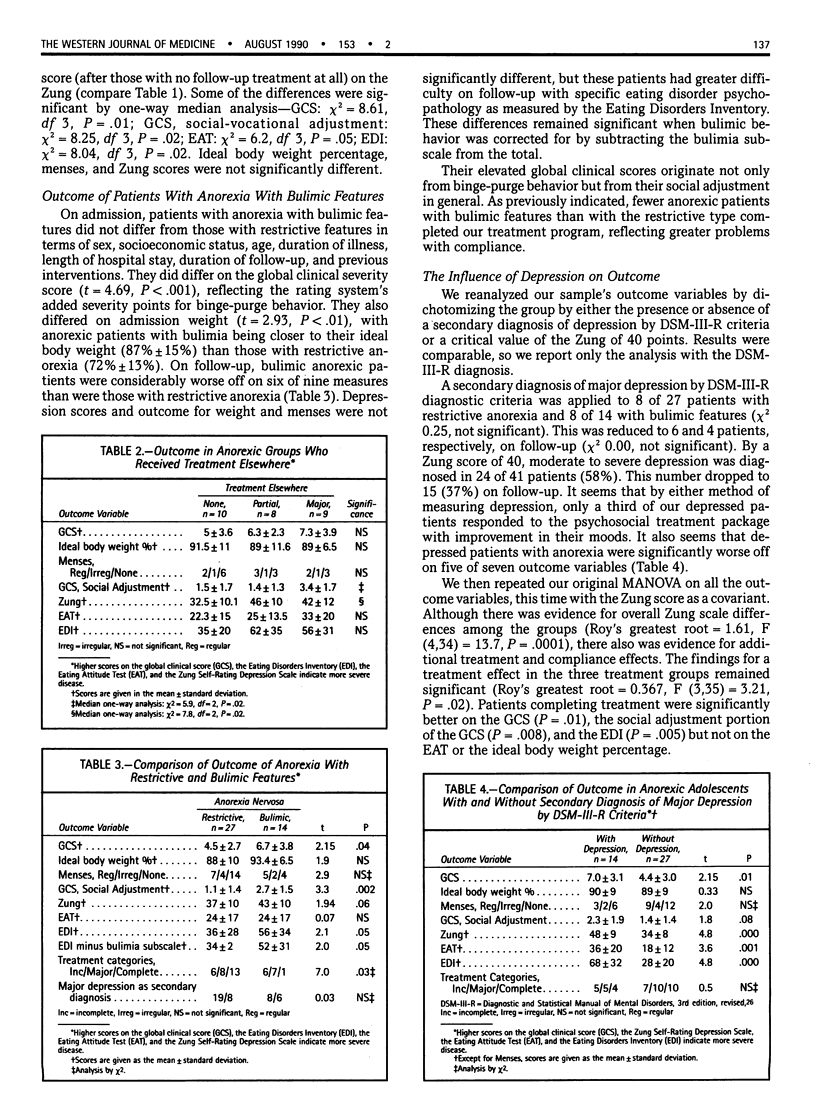

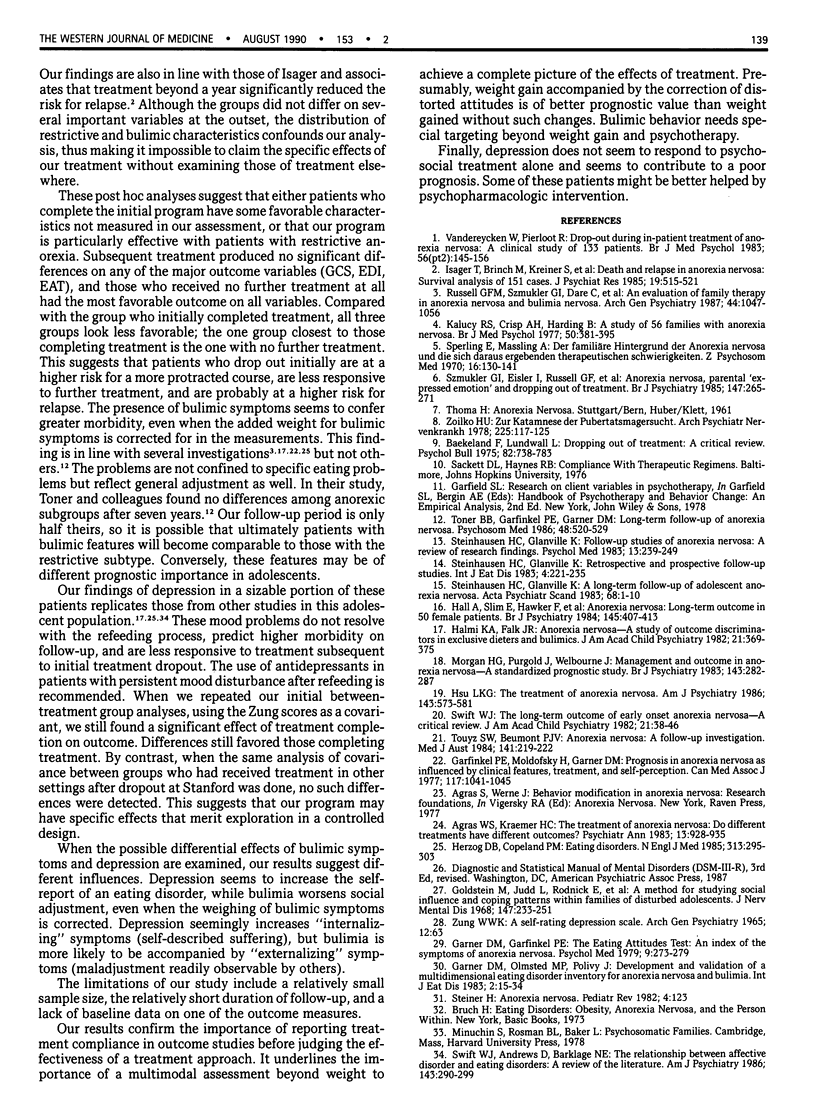
Selected References
These references are in PubMed. This may not be the complete list of references from this article.
- Baekeland F., Lundwall L. Dropping out of treatment: a critical review. Psychol Bull. 1975 Sep;82(5):738–783. doi: 10.1037/h0077132. [DOI] [PubMed] [Google Scholar]
- Garfinkel P. E., Moldofsky H., Garner D. M. Prognosis in anorexia nervosa as influenced by clinical features, treatment and self-perception. Can Med Assoc J. 1977 Nov 5;117(9):1041–1045. [PMC free article] [PubMed] [Google Scholar]
- Garner D. M., Garfinkel P. E. The Eating Attitudes Test: an index of the symptoms of anorexia nervosa. Psychol Med. 1979 May;9(2):273–279. doi: 10.1017/s0033291700030762. [DOI] [PubMed] [Google Scholar]
- Goldstein M. J., Judd L. L., Rodnick E. H., Alkire A., Gould E. A method for studying social influence and coping patterns within families of disturbed adolescents. J Nerv Ment Dis. 1968 Sep;147(3):233–251. doi: 10.1097/00005053-196809000-00002. [DOI] [PubMed] [Google Scholar]
- Hall A., Slim E., Hawker F., Salmond C. Anorexia nervosa: long-term outcome in 50 female patients. Br J Psychiatry. 1984 Oct;145:407–413. doi: 10.1192/bjp.145.4.407. [DOI] [PubMed] [Google Scholar]
- Halmi K. A., Falk J. R. Anorexia nervosa. A study of outcome discriminators in exclusive dieters and bulimics. J Am Acad Child Psychiatry. 1982 Jul;21(4):369–375. doi: 10.1016/s0002-7138(09)60940-7. [DOI] [PubMed] [Google Scholar]
- Herzog D. B., Copeland P. M. Eating disorders. N Engl J Med. 1985 Aug 1;313(5):295–303. doi: 10.1056/NEJM198508013130505. [DOI] [PubMed] [Google Scholar]
- Hsu L. K. The treatment of anorexia nervosa. Am J Psychiatry. 1986 May;143(5):573–581. doi: 10.1176/ajp.143.5.573. [DOI] [PubMed] [Google Scholar]
- Isager T., Brinch M., Kreiner S., Tolstrup K. Death and relapse in anorexia nervosa: survival analysis of 151 cases. J Psychiatr Res. 1985;19(2-3):515–521. doi: 10.1016/0022-3956(85)90061-5. [DOI] [PubMed] [Google Scholar]
- Kalucy R. S., Crisp A. H., Harding B. A study of 56 families with anorexia nervosa. Br J Med Psychol. 1977 Dec;50(4):381–395. doi: 10.1111/j.2044-8341.1977.tb02437.x. [DOI] [PubMed] [Google Scholar]
- Morgan H. G., Purgold J., Welbourne J. Management and outcome in anorexia nervosa. A standardized prognostic study. Br J Psychiatry. 1983 Sep;143:282–287. doi: 10.1192/bjp.143.3.282. [DOI] [PubMed] [Google Scholar]
- Russell G. F., Szmukler G. I., Dare C., Eisler I. An evaluation of family therapy in anorexia nervosa and bulimia nervosa. Arch Gen Psychiatry. 1987 Dec;44(12):1047–1056. doi: 10.1001/archpsyc.1987.01800240021004. [DOI] [PubMed] [Google Scholar]
- Sperling E., Massling A. Der familiäre Hintergrund der Anorexia nervosa und die sich daraus ergebenden therapeutischen Schwierigkeiten. Z Psychosom Med Psychoanal. 1970;16(2):130–141. [PubMed] [Google Scholar]
- Steinhausen H. C., Glanville K. A long-term follow-up of adolescent anorexia nervosa. Acta Psychiatr Scand. 1983 Jul;68(1):1–10. doi: 10.1111/j.1600-0447.1983.tb06974.x. [DOI] [PubMed] [Google Scholar]
- Steinhausen H. C., Glanville K. Follow-up studies of anorexia nervosa: a review of research findings. Psychol Med. 1983 May;13(2):239–249. doi: 10.1017/s0033291700050844. [DOI] [PubMed] [Google Scholar]
- Swift W. J., Andrews D., Barklage N. E. The relationship between affective disorder and eating disorders: a review of the literature. Am J Psychiatry. 1986 Mar;143(3):290–299. doi: 10.1176/ajp.143.3.290. [DOI] [PubMed] [Google Scholar]
- Swift W. J. The long-term outcome of early onset anorexia nervosa. A critical review. J Am Acad Child Psychiatry. 1982 Jan;21(1):38–46. doi: 10.1097/00004583-198201000-00008. [DOI] [PubMed] [Google Scholar]
- Szmukler G. I., Eisler I., Russell G. F., Dare C. Anorexia nervosa, parental 'expressed emotion' and dropping out of treatment. Br J Psychiatry. 1985 Sep;147:265–271. doi: 10.1192/bjp.147.3.265. [DOI] [PubMed] [Google Scholar]
- Toner B. B., Garfinkel P. E., Garner D. M. Long-term follow-up of anorexia nervosa. Psychosom Med. 1986 Sep-Oct;48(7):520–529. doi: 10.1097/00006842-198609000-00007. [DOI] [PubMed] [Google Scholar]
- Touyz S. W., Beumont P. J. Anorexia nervosa. A follow-up investigation. Med J Aust. 1984 Aug 18;141(4):219–222. [PubMed] [Google Scholar]
- Vandereycken W., Pierloot R. Drop-out during in-patient treatment of anorexia nervosa: a clinical study of 133 patients. Br J Med Psychol. 1983 Jun;56(Pt 2):145–156. doi: 10.1111/j.2044-8341.1983.tb01542.x. [DOI] [PubMed] [Google Scholar]
- ZUNG W. W. A SELF-RATING DEPRESSION SCALE. Arch Gen Psychiatry. 1965 Jan;12:63–70. doi: 10.1001/archpsyc.1965.01720310065008. [DOI] [PubMed] [Google Scholar]


